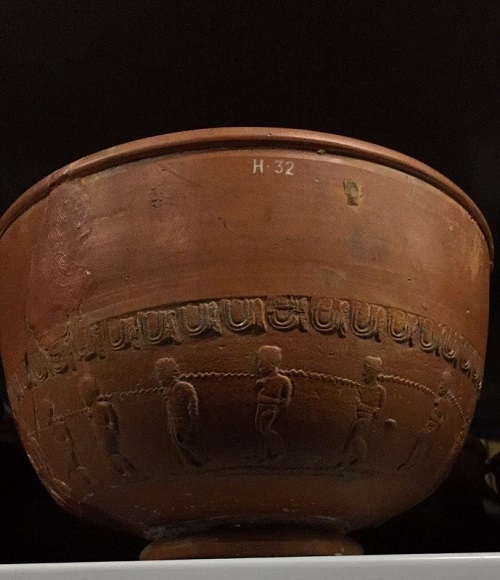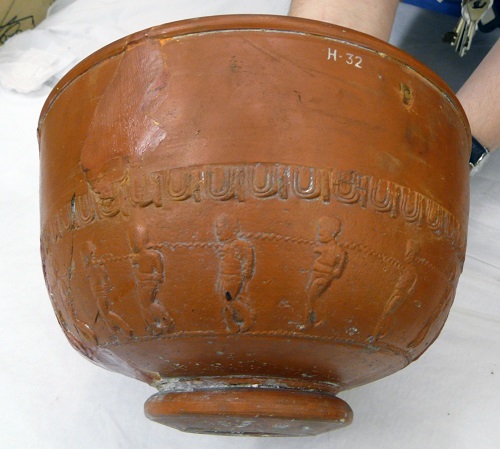Bowl and Chain: Slavery in Roman Yorkshire – by Emily Tilley, Collections Facilitator for Roman Archaeology
Emily Tilley, Collections Facilitator for Roman Archaeology, is currently working on the ‘Old Collections, New Questions’ Roman Research Project, collaborating with curators, experts, researchers, volunteers, and enthusiasts to look at York Museums Trust’s Roman collections in new ways.
As part of the ‘Old Collections, New Questions’ Roman Research Project I am carrying out an audit of all the Roman collections held by YMT. This means I’m coming into contact with a huge number of amazing artefacts in storage.
One of my favourite off-display Roman objects is this samian ware bowl (YORYM : H32), which was found in 1873 during the York Railway excavations. The bowl is decorated with a row of eleven captives, chained together at the neck and ankle. Roman captives, seized during Rome’s military campaigns, often went on to face execution or slavery.

Roman samian ware bowl (YORYM : H32) depicting captives chained at neck and ankle.
Recent research has vastly improved our understanding of the bowl’s significance. Patrick Ottaway, author of the books Roman York and Roman Yorkshire, recently brought this artefact to the attention of ceramics expert Joanna Bird. She informed us that the bowl is decorated in the style of Maiiaus of Trier, giving it a date range of AD 170-240, although Bird believes the style of the rim and base indicate that it can be placed late in that range. Only one side of the original bowl has survived; the other half has been reconstructed without decoration. This unfortunately means that half of the original imagery has been lost.
However, similar ceramics show that the final captive in the row would have been chained to a column, and that sometimes two or three bestiarii (gladiators who fought wild animals) were also depicted holding whips. This is one of very few representations of Roman captives or slaves in the YMT collections, and as such can shed light on an often overlooked aspect of life in Roman Yorkshire.

Samian ware bowl (YORYM : H32) from a different angle showing chain detail.
Slaves left few archaeological traces. They had few material possessions to leave behind, and those that they did have rarely survive through time. It is therefore difficult to explore the stories of slaves through material culture, and artefacts like this offer huge value as a tangible link to this hidden aspect of Roman life.
It is important to acknowledge, however, that this bowl does not offer a slave’s perspective. It is a good-quality household item that celebrates Rome’s conquests over the ‘barbarians’ it depicts, shown near-naked and bearded to emphasise their ‘otherness’. As such it sheds light on how slavery was perceived by Roman citizens. It reveals the normality of slavery throughout the empire; slaves were an accepted part of the Roman social hierarchy, and a familiar part of everyday life.
Many slaves lived in Roman cities like York, working as tutors, maids, shopkeepers, scribes or apprentices. Some worked in rural Yorkshire, in the households of wealthy countryside villas or as farmworkers. Slaves played an important role in the rural and urban economy. Some were also put to work in mines, where conditions were notoriously difficult and life expectancies were short.
It is also worth noting that Roman gladiators had the status of slaves and were regularly subjected to violence, injury, and even death for the entertainment of Roman citizens. How each individual slave was treated was subject to the discretion of their masters and mistresses. Living conditions were extremely variable.
A Roman slave was not necessarily a slave for life. Slaves were able to obtain their freedom in many ways. Some saved enough money to buy their freedom, some were freed following the deaths of their masters, and others were freed for reasons of loyal service, old age or marriage.
Upon obtaining their freedom slaves would enter the social ranks of freedmen and freedwomen, often still remaining closely tied to their ex-owners’ businesses and households through patronage, trade, and sometimes family connections. Freedmen and women did not have the full rights of a freeborn Roman citizen but any children they went on to have would enjoy full citizenship. Slaves, ex-slaves, and the children of ex-slaves played a very important commercial and social role in Roman Yorkshire.
Follow @YMT_YorkRomans on Twitter for regular updates from the ‘Old Collections, New Questions’ Roman Research Project, and keep an eye out for more blog posts as new research comes to light.

